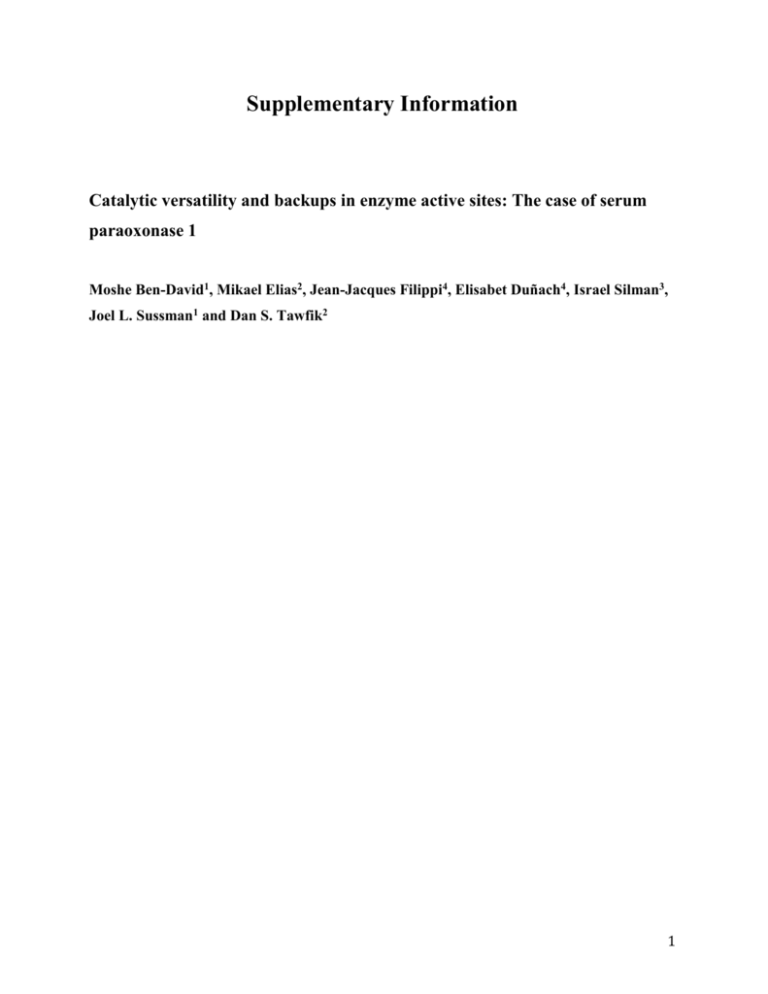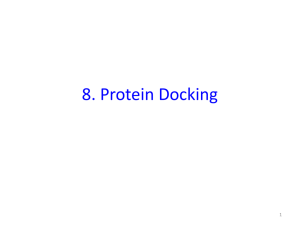Supplementary Material
advertisement

Supplementary Information Catalytic versatility and backups in enzyme active sites: The case of serum paraoxonase 1 Moshe Ben-David1, Mikael Elias2, Jean-Jacques Filippi4, Elisabet Duñach4, Israel Silman3, Joel L. Sussman1 and Dan S. Tawfik2 1 Figure 1. Overlays of the original rePON1 structure obtained at pH 4.5 (1V04, orange) and of the new 2Å structure obtained at pH 6.5 (light blue). (A) Backbone representation of the activesite region (the catalytic calcium is shown as a green sphere, and the bound phosphate anion in sticks). (B) The observed changes in side-chain rotamers of residues 346-348 at the active site second-shell. 2 Figure 2. Chemical structure of substrates and their putative TS analogs used in this study. 3 Tables 1-3. Kinetic parameters of the alanine mutants of the active-site loop residues. Table 1. Phosphotriesterase activity measured with paraoxon Protein K70A Y71A P72A G73A I74A M75A S76A F77A D78A P79A D80A K81A rePON1 KM (mM) 2.96±0.2 9 1.91±0.1 2 1.52±0.1 0 2.46±0.1 2 4.88±0.4 0 >5a 2.35±0.1 3 >5a 1.86±0.1 4 2.11±0.2 1 2.12±0.1 4 2.12±0.1 4 2.3±0.3 kcat (s-1) kcat/KM (s-1M-1) rePON1(kcat/KM) /mutant(kcat/KM) 3.75±0.71 1264±123 1.7±0.5 0.24±0.01 124±8 17.4±3.4 1.69±0.36 1110±69 1.9±0.6 0.86±0.09 347±17 6.2±1.3 0.40±0.03 --- 83±7 370±35b 25.8±5.2 5.8±1.1 3.21±0.05 --- 1369±74 370±54b 1.6±0.3 5.8±1.2 3.40±0.51 1829142 1.2±0.3 2.62±0.72 1241±126 1.7±0.6 2.48±0.38 1169±78 1.8±0.5 4.94±0.24 5.01±0.59 3136±124 2149±301 0.7±0.1 1.0 a Because of limited substrate solubility, the reaction rates did not show saturation and only an upper limit for the KM value was provided based on the maximal substrate concentration used. b Catalytic efficiency was obtained by linear fit of initial velocity to substrate concentration. Table 2. Lactonase activity measured with TBBL Protein KM (mM) kcat (s-1) kcat/KM (s-1M-1) rePON1(kcat/KM) /mutant(kcat/KM) K70A Y71A P72A G73A I74A M75A S76A F77A 1.94±0.41 4.87±1.18 1.23±0.39 1.82±0.16 1.69±0.17 1.76±0.13 0.70±0.09 2.48±0.18 161.57±7.62 40.95±6.42 154.33±3.34 79.44±3.62 251.71±0.89 165.19±6.98 149.37±9.68 165.66±6.42 83370±17704 8411±2045 125535±39740 43599±3722 149265±14843 93753±6712 212718±28763 66763±4830 2.0±0.5 20.1±6.4 1.3±0.5 3.9±0.6 1.1±0.2 1.8±0.3 0.8±0.2 2.5±0.4 4 D78A P79A D80A K81A rePON1 0.72±0.05 88.99±2.95 1.23±0.15 136.91±7.76 0.96±0.06 133.85±4.35 0.93±0.12 167.81±13.34 1.12±0.12 188.61±15.89 123849±8703 111184±13611 139082±8919 180912±23748 169104±17947 1.4±0.2 1.5±0.3 1.2±0.2 0.9±0.2 1.0 Table 3. Aryl-esterase activity measured with phenyl acetate Protein K70A Y71A P72A G73A I74A M75A S76A F77A D78A P79A D80A K81A rePON1 KM (mM) >5 a 2.52±0.19 2.80±0.20 4.39±0.36 >5 a >5 a 2.65±0.12 >5 a 1.07±0.08 0.57±0.16 3.65±0.16 1.72±0.07 2.66±0.26 kcat (s-1) --73.9±1.7 689.6±28.3 328.1±5 ----354.1±11.1 --397.2±13 525.6±3.4 572±18.8 718.6±9.8 927±17.8 kcat/KM (s-1M-1) 28872±396 b 29398±1615 246410±6286 75064±5299 15642±315 b 69084±1693b 133466±2093 45785±1389 b 370537±15113 147393±6118 156645±3049 419303±10774 350576±33250 rePON1(kcat/KM) /mutant(kcat/KM) 12 12 1.5 4.5 22.4 5 2.6 7.6 1 2.4 2.3 0.8 1 5 Figure 3. Docking models of rePON1 with the inhibitor 2HQ. (A) Docking model of 2HQ (cyan) within the close structure of rePON1 (the structure the 2HQrePON1 was used as template after removing 2HQ). (B) Superposition of the docking model within the close structure (cyan) and the actual structure of rePON1 with 2HQ (green olive). C. Superposition of the docking model within the open structure at pH 6.5 (dark blue) and the crystal structure of rePON1 bound with 2HQ (green olive). 6 Figure 4. Docking models of rePON1 with S-dodecanoic--lactone, and the corresponding oxyanionic reaction intermediate, within the close structure (the rePON1-2HQ complex, with 2HQ removed). (A) The model for S-dodecanoic--lactone. (B) Superposition of the model of S-dodecanoic-lactone (cyan) with 2HQ from the actual crystal structure (olive green). (C) Model of the oxyanionic tetrahedral reaction intermediate of S-dodecanoic-lactone. (D) Superposition of the oxyanionic reaction intermediates of phenylacetate (pink) and S-dodecanoic--lactone (dark blue). 7 Figure 5. Docking models of rePON1 with S-dodecanoic--lactone, and the corresponding reaction intermediate, within the close structure (the rePON1-2HQ complex with 2HQ removed). (As Fig. S6 above, but with -instead of -lactone). (A) The model for S-dodecanoic--lactone. (B) Superposition of the model of Sdodecanoic--lactone (cyan) with 2HQ from the actual crystal structure (olive green). (C) Model of the oxyanionic tetrahedral reaction intermediate of S-dodecanoic-lactone. (D) Superposition of the oxyanionic reaction intermediates of S-dodecanoic-γ-lactone (pink) and S-dodecanoic--lactone (dark blue). 8 . Figure 6. Docking models of rePON1 with R and S isomers of thio--lactone substrates, and of the corresponding reaction intermediates, within the close structure (the rePON12HQ complex, with 2HQ removed). (A) The model for the R isomer. (B) Docking of the oxyanionic tetrahedral reaction intermediate of the R isomer. (C) Docking model for the S isomer. (D) Docking of the oxyanionic tetrahedral reaction intermediate of the S isomer. 9 Figure 7. Docking models of rePON1 with phenylacetate and of the corresponding reaction intermediates, within the close structure (the rePON1-2HQ complex, with 2HQ removed). (A) The model for phenylacetate. (B) Superposition of the phenylacetate model (magenta) with 2HQ taken from the same structure (pink). (C) Superposition of the model of the oxyanionic intermediate state of phenyl acetate (pink) and the model of paraoxon (ground state, in yellow) in the open structure (pH6.5). (D) Superposition of the substituted aryl-ester 4AAP molecule (4-acetoxy-acetophenone; pink) with the model for phenylacetate (dark blue). The active site volume cavity is shown as a light grey surface. (E) Superposition of the docking model of 4AAP (pink) with the model of phenylacetate (magenta). 10 Figure 8. Randomly chosen models from the docking attempts of paraoxon within the close active-site configuration. Four random orientations of paraoxon (blue sticks) are shown (A-D). The surface of the active-site cavity of the close configuration is shown in transparent white. 11 12 Figure 9. Docking models of rePON1 with paraoxon and its oxyanionic reaction intermediate. (A) Docking model of paraoxon within the open conformation. (B) Superposition of paraoxon (ground state, yellow) and its pentacoordinated oxyanionic hydrolytic intermediate (yellow-orange) within the open conformation. (C) Docking model of paraoxon within the open structure of PON1 (as in A) with the active site cavity of the close configuration shown as a light grey surface. (D) Superposition of paraoxon with 2HQ from the close crystal structure of rePON1 (olive green). (E) Docking model of paraoxon obtained with the close structure of rePON1 while allowing the side-chains of Y71 and I74 to move freely during the docking simulations. The conformations of these residues as seen in the crystal structure are shown as green sticks, and the computed as pink sticks. (F) Docking model of the pentacoordinated oxyanionic hydrolysis intermediate of paraoxon obtained as in part E. The original conformations of Y71 and I74 are shown as green sticks, and the calculated as pink sticks. 13 Figure 10. Docking models of rePON1 with dihydrocoumarin and its reaction intermediate. (A) The model of dihydrocoumarin within the close conformation. (B) Superposition of the docking model of dihydrocoumarin (white) with the inhibitor 2HQ (the close conformation; olive green). (C) Superposition of the model of dihydrocoumarin (ground state, white) and its oxyanionic tetrahedral intermediate (dark grey). (D) Superposition of the oxyanionic intermediate of dihydrocoumarin (dark grey) and the pentacovalent reaction intermediate of paraoxon (yellow). 14 Figure 11. Superposition of the rePON1 (apo structure at pH 6.5) and the structure of the glucuronolactonase from Xanthomonas campestris (pdb ID: 3DR2). (A) Superposition of the rePON1 structure (green sticks) with molecule A of the asymmetric unit of the glucuronolactonase structure (pink sticks). Distances are given for the calcium ion in the rePON1 structure. (B) Superposition of the rePON1 structure (green sticks) with molecule B of the glucuronolactonase structure (pink sticks). Distances are given for the glucuronolactonase structure. The water molecule bridging E48 and the calcium cation is shown as a red sphere. 15 Table 4. Summary of the docking models with the 2HQ inhibitor (experimentally measured Ki= 0.9-2.7 µM) Enzyme conformation Predicted binding energy (kcal/mol) Predicted Ki (µM) Contacting residues F222 close open -7.3 -5.9 4.7 51.9 + + F292 + + L240 + + I291 + + V346 + + L69 + - D269 + + N224 + + N168 + + H285 + + H115 + + E53 + + Y71 + - I74 + - M196 - - 16 Table 5. Summary of the docking models with with various lactone substrates. Substrate S-δdecanoic thiolactone R- δdecanoic thiolactone S-δdodecanoic lactone Catalytic efficiency (s-1. M-1) 8900 4100 n.d. n.d. n.d. n.d. close close KM Enzyme conformation Liganda Contacting residues F222 F292 L240 I291 V346 L69 D269 N224 N168 H285 H115 E53 Y71 I74 close S-γ-dodecanoic lactone Dihydrocoumarin 1.23x105 (measured with racemate) 220µM open close 1.19x106 129 µM open close open GS TS GS TS GS TS GS TS GS TS GS TS GS TS GS TS + + + + + + + + + + + + + + + + + + + + + + + + + + + + + + + + + + + + + + + + + + + + + + + + + + + + + + + + + + + + + + + + + + + + + + + + + + + + + + + + + + + + + + + + + + + + + + + + + + + + + - + + + + + + + + + + + - + + + + + + + + + + + + + + + + + + + + + + + + + + + + + + + + + + + - + + + + + + + + + + - + + + + + + + + + + + + + + + + + + + + + + + - 17 + + + + + + + + + + + - M196 - + - + docked ligand: Substrate (GS), or oxyanionic tetrahedral reaction intermediate (TS). - - - - a The 18 Table 6. Docking calculation summary with phenylacetate, 4AAP (aryl-esters) and paraoxon (phosphotriester). Activity Substrate Catalytic efficiency (s-1. M-1) KM Enzyme conformation Liganda Contacting residues F222 Aryl-esterase Phenylacetate 4AAP Phosphotriesterase Paraoxon 5.95x105 5.1 x103 5.8x103 1.2mM 2.6 0.8mM close open close closeb open GS TS GS TS GS GS TS GS TS + + + + + + + + + F292 + + + + + + + + + L240 + + + + - + + + + I291 + + + + + + + + + V346 + + + + + + + + + L69 - - - - + + + + + D269 + + + + + + + + N224 + + - - + + + + N168 + + + + + + + + + H285 + + + + + - - + + H115 + + + + + + + + + E53 - + - + + - + - + Y71 + + - - + + + - - I74 + + - - + + + - - - - M196 docked ligand: Substrate (GS), or oxyanionic tetrahedral reaction intermediate (TS). bDocked in the close structure of rePON1 with I74 and Y71 as flexible residues a The 19






